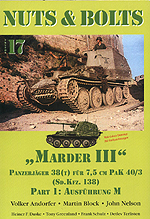| Home > Reviews > Germany WWII > Nuts & Bolts 17: "Marder III" |
|
 |
Published by Nuts & Bolts c/o Frank Schulz, Mullerstr. 6, 29525 Uelzen, Germany No ISBN available. |
Once again the Nuts & Bolts team has produced a winner for everyone keen on German armour, and in particular this time for builders of the fairly new Tamiya kit. This book has 128 pages and covers its subject in exhaustive detail.
As usual the book is bilingual English/German, and it starts with notes on the development of the basic chassis and the gun before going into detailed technical descriptions of both the Ausf H and Ausf M Sd.Kfz. 138 vehicles. A sign, I hope that part 2 will deal with the Ausf H. Radio fits are also looked at, including those for command vehicles, and then there is a brief section of camouflage and markings.
All this takes us up to page 10, and then comes a 6-page section on production and allocation to units – again dealing with both Ausfs, and including detailed tables listing the units equipped with “138”s and the dates they received them. The next 13 pages go into self-propelled anti-tank unit organisation in theory and practice, with combat histories of PzJagAbt 28 (2 Pz Div) PzJagAbt 10 (10 Inf Div, later 10 PzGren Div), PzJagAbt 171 (71 Inf Div), SS-PzJagAbt 1 (LSSAH), and PzJagAbt 744 (Heerestruppe) right up to the end of the war. Two more tables show the known users at 30 December 1944 and 15 March 1945, in both cases with operational and “under repair” figures from the unit returns. To end the text section there are short notes on modelling the Ausf M – the inside end covers show a superb model by David Parker in full colour.
Next come 25 pages of wartime photographs, some factory shots but mostly in unit service. 63 shots in all, including some real gems – how about one captured in Italy and used against its former owners, shown in 4 photographs including its full British unit markings. The captions are very informative, and even point out a very rare example with the very early internal exhaust pipe. All these are followed by six David Parker colour plates showing colour schemes, a 5-view 1/35 scale plan of the early Ausf M and three isometric drawings of the late type.
We’re only halfway through the book at this point, and the remaining pages are devoted to detailed close-up photographs of surviving Ausf Ms at Aberdeen Proving ground, Saumur, the Victory Museum in Arlon and the Henriques Collection in Trieste. The exterior, the fighting compartment and the driver’s area are completely covered here. There are even shots showing part of the engine bay in the Saumur example with its incomplete engine – none of a complete engine in its bay, presumably either because there isn’t a complete survivor to photograph or, perhaps, because there wasn’t room in this book and they’ll be in Part 2.
Very highly recommended to all fans of German armour!
John Prigent
| |
|
|